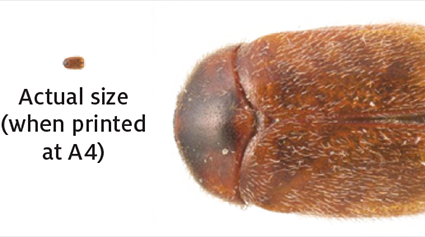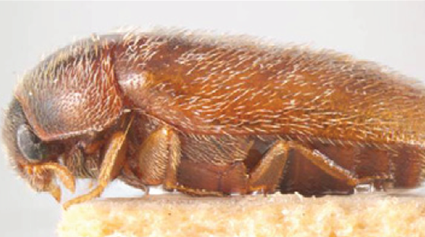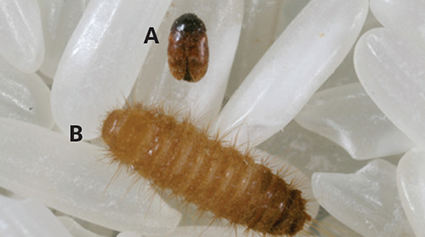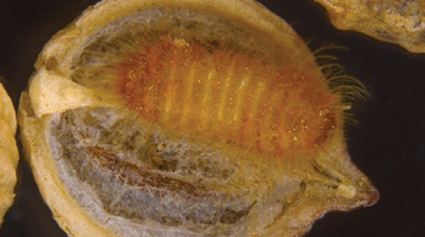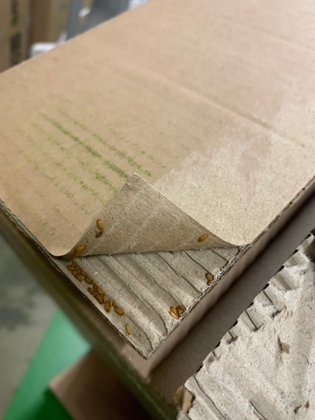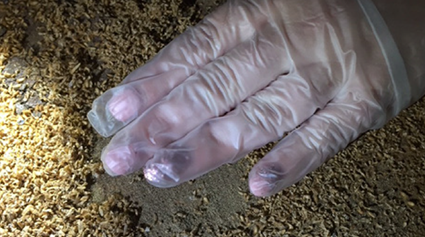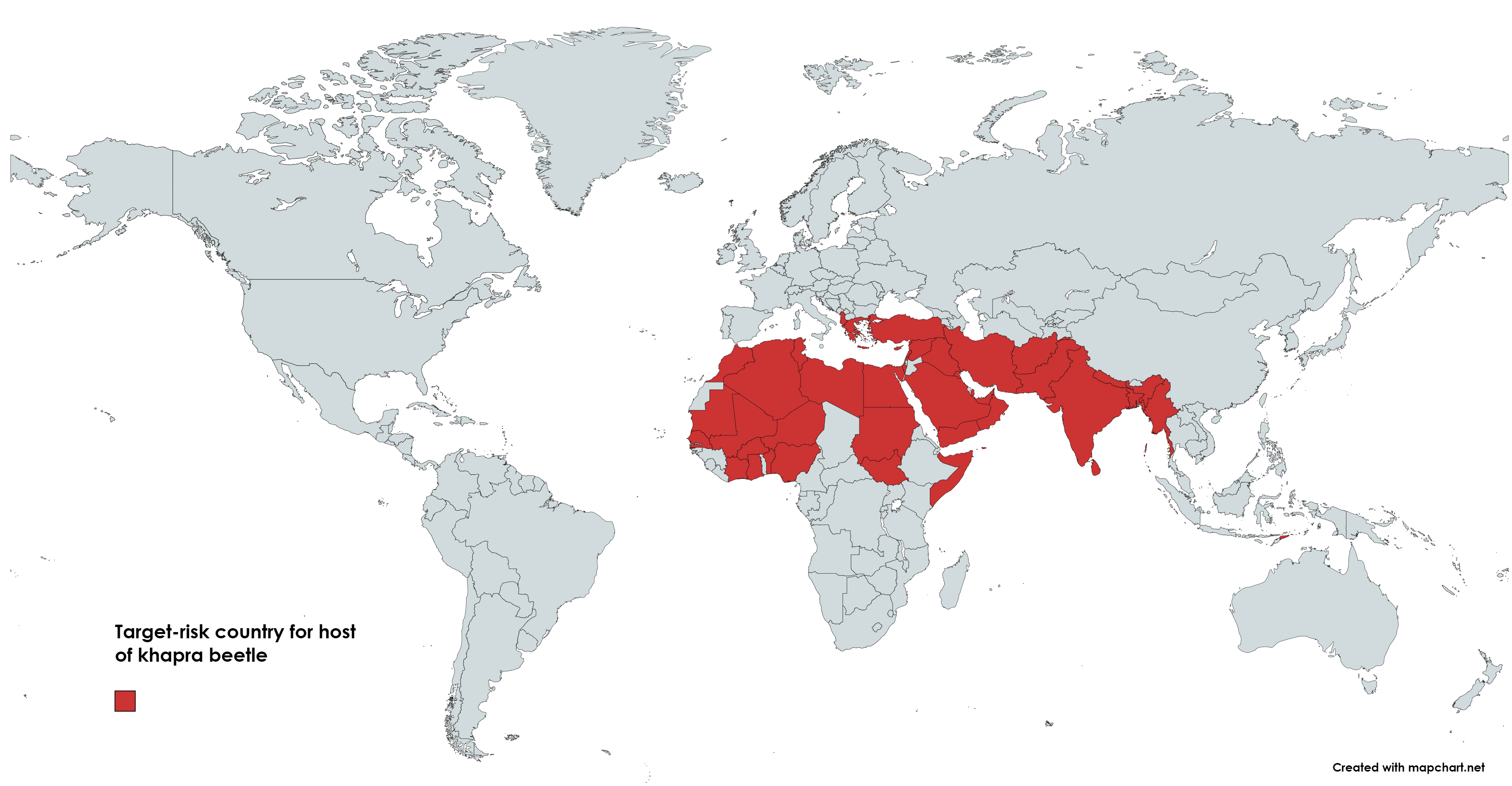Download
Khapra beetle bulletin - March 2022 (PDF 636KB)
If you have difficulty accessing this file, visit web accessibility for assistance.
What is khapra beetle?
Khapra beetle (Trogoderma granarium) is Australia’s number two National Priority Plant Pest and the number one plant priority pest for grains. It is not present in Australia, but it is a highly invasive pest that poses a major threat to Australia’s grains industry. It feeds directly on goods such as stored grain and dry food stuffs, which can result in significant damage. Infested goods may become contaminated with beetles and cast larval skins and hairs, which can be a health risk and are difficult to remove from grain storage structures and transport vessels.
What does it look like?
Adults are 1.6–3mm long, oval shaped and light yellowish brown to dark brown in colour. Adult beetles have many fine hairs and indistinct markings on their wing covers. When viewed from the side, the adult beetle’s partly concealed head and downward facing mouthparts can be seen (Figure 2).
Eggs are less than 1mm long and milky white to pale yellow in colour.
Larvae are 1.6–4.5mm long, golden brown in colour, and have distinctive hairs across the body, including longer hairs at the end of the body that resemble a tail (Figure 3 and 4).
Pupae have a similar appearance to late stage larvae except that they are slightly shorter and more rounded.
What can it be confused with?
Khapra beetle can be confused with the warehouse beetle (Trogoderma variabile) and native Trogoderma species. If you find a beetle that resembles khapra beetle, please report it and have it identified by an expert.
What should I look for?
Khapra beetle can be found in stored products and around places where stored products have been kept or transported, including between cracks and under floors of storage containers and packaging material (Figure 5). The most common signs of infestation are larvae and the presence of cast larval skins (Figure 6). There may also be visible signs of damage and waste.
To check for infestations, inspect all cracks and crevices in storage areas, and under bags. For shipping containers, pay attention to any residual contaminants, e.g. grains, as these are a food source for khapra. For bagged consignments, pay particular attention to the inner corners or ears of the bags.
What is its life cycle?
Mating between adult male and female beetles occurs around 2–3 days after emergence. Shortly after mating, adult females begin laying eggs in or near host material and generally lay 50–100 eggs during their lifetime. Eggs hatch within 5–7 days into larvae, which are the major feeding stage and therefore the most damaging. Larvae moult four or more times, resulting in numerous cast larval skins. The larval development period can be as short as 30 days, but larvae can also survive in a dormant state for several years in unfavourable conditions. The larva finally develops into an immobile pupa, from which the adult emerges.
Adults are short-lived, do not feed much, and although they are winged, they are not known to fly. There can be up to ten generations per year during warm, dry conditions, which can quickly result in damaging infestations.
How can the pest enter Australia?
The most likely pathway for khapra beetles to enter Australia is with the movement of contaminated goods, including grains, food stuffs, personal effects and as a hitchhiker in shipping containers and a wide range of cargo (plastic beads, nuts and bolts, timber doors).
It has been recorded infesting more than 100 commodities including most dried plant products, such as wheat, maize, barley, rice, millet, sorghum, pulses, cotton, sunflower, sesame and spice seeds, and some animal products.
It can survive as a hitchhiker pest in shipping containers for a number of years. Due to its small size, its ability to survive for extended periods without food and its preference for inhabiting crevices it can remain undetected under floors and in cracks and crevices in shipping containers. When conditions are favourable beetle populations can quickly increase in size and can contaminate any goods held within the container.
Global distribution
Khapra beetle is native to India, but has spread to many parts of Africa, Asia, Europe and the Middle East. A full list of target risk countries can be found on our website.
We have identified the following countries as those where khapra beetle is present:
Please note the list of khapra beetle target risk countries is subject to change.
How can you protect your grain stores from infestation?
Check your stored grain, storage facilities, pantry, and any shipping containers frequently for the presence of pests and damage. Good hygiene and pest management plays an important role in limiting infestation, including the removal of spillages and residues and the sealing of any cracks or crevices where pests could hide.
Report your find
If you find a khapra beetle or signs of infestation, secure the goods immediately. Stop all movement of goods and immediately report it to the department. Phone the See. Secure. Report Hotline on 1800 798 636. Learn more in our cargo pest video.

